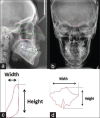Correlation between frontal sinus dimensions and cephalometric indices: A cross-sectional study
- PMID: 28435368
- PMCID: PMC5379838
- DOI: 10.4103/1305-7456.202630
Correlation between frontal sinus dimensions and cephalometric indices: A cross-sectional study
Abstract
Objective: Growth prediction plays a significant role in accurate diagnosis and treatment planning of orthodontics patients. It was hypothesized that the unique pattern of pneumatization of the frontal sinus as a component of craniofacial structure would influence the skeletal growth pattern and may be used as a growth predictor.
Materials and methods: A total of 144 subjects (78 females and 66 males) with a mean age of 19.26 ± 4.66 years were included in this retrospective study. Posterior-anterior and lateral cephalograms (LCs) were used to measure the frontal sinus dimensions. The skeletal growth pattern and relations of craniofacial structures were analyzed on LC using variables for sagittal and vertical analyses. Correlation between the frontal sinus dimensions and cephalometric indices was assessed by the Pearson's correlation coefficient.
Results: The SN-FH and SNA angles had significant associations with frontal sinus dimensions in all enrolled subjects (P < 0.05). In males, the SN-FH, sum of posterior angles, Pal-SN, and Jarabak index were significantly associated with the size of frontal sinus (P < 0.05). In females, the associations of SN-FH and gonial angles with frontal sinus dimensions were significant (P < 0.05).
Conclusion: The results show that larger size of frontal sinus was associated with reduced inclination of the anterior cranial base, increased anterior facial height (in males), and increased gonial angle (in females) in the study population.
Keywords: Analysis; anatomic variation; cephalometry; frontal sinus; radiography.
Conflict of interest statement
There are no conflicts of interest.
Figures
References
-
- Turchetta BJ, Fishman LS, Subtelny JD. Facial growth prediction: A comparison of methodologies. Am J Orthod Dentofacial Orthop. 2007;132:439–49. - PubMed
-
- Oueis H, Ono Y, Takagi Y. Prediction of mandibular growth in Japanese children age 4 to 9 years. Pediatr Dent. 2002;24:264–8. - PubMed
-
- Aki T, Nanda RS, Currier GF, Nanda SK. Assessment of symphysis morphology as a predictor of the direction of mandibular growth. Am J Orthod Dentofacial Orthop. 1994;106:60–9. - PubMed
-
- Collin-Osdoby P, Rothe L, Anderson F, Nelson M, Maloney W, Osdoby P. Receptor activator of NF-kappa B and osteoprotegerin expression by human microvascular endothelial cells, regulation by inflammatory cytokines, and role in human osteoclastogenesis. J Biol Chem. 2001;276:20659–72. - PubMed
-
- Rossouw PE, Lombard CJ, Harris AM. The frontal sinus and mandibular growth prediction. Am J Orthod Dentofacial Orthop. 1991;100:542–6. - PubMed
LinkOut - more resources
Full Text Sources
Other Literature Sources
Research Materials
Miscellaneous


